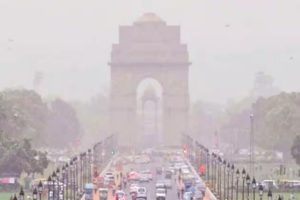The recent flood devastation across all major cities, was preceded by frequent fire accidents in offices, coaching classes, hospitals, gaming zones etc. Then, the monsoon rains saw the collapse of dozens of dilapidated buildings, with the death of their occupants. The diverse nature, and wide geographical sweep, of such tragedies, points to serious shortcomings in municipal administration across India. Things were much better earlier. Urban Local Bodies have a long history; the first Municipal Corporation was set-up in Madras (now Chennai) in 1688, which was preceded only by London; similar corporations were established in Bombay (now Mumbai) and Calcutta (now Kolkata) in 1726.
Eminent people headed these Municipal Corporations and tourists and residents, both, swore by their efficiency. Later on, in 1882, Lord Ripon, ‘the Father of Local-Self Government in India’, gave Indians the right to local self-government. By the time of Independence, almost all cities had a municipality. Still later, the 74th Amendment to the Constitution (1992) gave legal shape to Urban Local Bodies, comprehensively defining their powers and responsibilities. However, despite legislative empowerment, and allocation of considerable resources to Urban Local Bodies, their performance has been less than satisfactory.

Almost all ULBs are mired in politics, because political leaders want to control cash-rich municipal corporations. The Municipal Corporation of Delhi, one of the largest municipal bodies in the world, catering to more than two crore citizens, witnesses a daily tug-of war between the LG and the CM. Then, for political reasons, elections to the Brihanmumbai Municipal Corporation have been on hold since March 2022 and polls for Bruhat Bengaluru Mahaagara Palike are pending since September 2020.
The public is the sufferer; with no effective supervision at ground-level, municipal hospitals, schools, waste management systems etc. function suboptimally, and dishonest contractors make merry. Corruption is so deeply ingrained in municipal administration that even High Courts find themselves unable to enforce their writ in municipal matters; after the devastating floods of 2023, the Delhi High Court issued a slew of directions to ensure better coordination between different departments, control waterlogging, manage drainage systems, and improve the condition of water bodies. Scarcely three months later, the 2024 floods revealed that hardly any of the High Court’s directions had been carried out. Hearing 2024 flood-related cases, the High Court observed that a major reason for water logging was permitting construction of multi-storeyed buildings in places that had no proper draiage. The High Court further observed that the Government was not collecting taxes, leading to bankruptcy of civic bodies. Recently, 33 people were killed in a fire that broke out in a gaming zone in Rajkot.
The amusement park was built in 2022, in a tin roofed, two-floor ed temporary structure, which had insufficient fire extinguishers and emergency exits. Most importantly, the building had no fire safety certificate. During a hearing in Gujarat High Court, it emerged that the Rajkot collector, DDO, Municipal Commissioner, Superintendent of Police, all were present at inauguration of the gaming zone. The Chief Justice remarked “You have given him a licence by your presence at the inauguration that look I am here, do whatever you want to do…You are sacking the smaller fish. The big fish who were at the inauguration, where are they? Why have you not trapped them? Why have you not fixed responsibility on them?” Another judge asked: “So you were ignorant of these structures existing in the vicinity? So, you were blind to it, that these big structures existed, you were unaware of it for eighteen months? Was fire safety applied for it? Did you inspect?”
The Chief Justice observed “We also require that … an inquiry be conducted into the working of the municipal corporations in the state in view of recent incidents reflecting dereliction of duties on the part of the municipal commissioners …which have become evident with unfortunate incidents such as the Morbi Bridge Collapse, Harni Lake boat tragedy and Rajkot TRP gaming zone fire incident.” A parallel can be drawn with the Grenfell Tower fire in London; a public inquiry uncovered a litany of failings, dishonesty and greed of construction companies, and the failure of politicians to act on citizens’ concerns, resulting in the death of 72 unfortunate people. The 74th Amendment is often blamed for providing an incomplete roadmap that has led to the present maladministration in civic bodies, but this is not true; the amendment did leave considerable discretion with Sta te Governments, but Parliament could never have imagined that State Governments would implement the amendment in a way that effective control over civic bodies will not pass to elected councillors, but remain with the State Government.
All Corporations have a Municipal Commissioner, a nominee of the State Government, who calls the shots, as all executive powers vest in him. A survey by Janaagraha, a Bengaluru-based NGO, indicates that States have implemented only 42 per cent of the provisions of the 74th Amendment meant to empower local urban bodies. The 74th Amendment envisages transfer of eighteen functions to civic bodies, but so far, no State has transferred all the eighteen functions to them. Additionally, municipal finances are in poor shape. According to an analysis of budgetary data for 201 municipal corporations by RBI in their ‘Report on Municipal Finances’ (November 2022), municipal expenditure in India declined from 2012-13 to 2017-18, though the urban population increased significantly. According to the Report, establishment cost increased, capital expenditure was minimal, while revenue expenditure declined from 70 percent to 58 percent of the municipal budget.
The Report noted that municipal taxes and user charges were grossly inadequate to meet expenditure needs of municipal bodies, and there were elaborate state government controls on their authority to levy taxes and user charges, setting of rates, granting of exemptions, and borrowing of funds, as well as on the design, quantum and timing of transfer of funds. The report also noted that in terms of fiscal autonomy, ULBs in India were among the weakest globally. The size of municipal budgets in India were much smaller than peers in other countries, with municipal expenditure in India at around 1 percent of GDP, while municipal expenditure accounted for 7.4 per cent of GDP in Brazil, and 6 percent of GDP in South Africa.
To provide the required funds to municipalities, the Report suggested earmarking of one-sixth of GST collections for municipalities, and floating of municipal bonds. However, implementation of these recommendations may not be possible; cash-strapped governments are unlikely to forego GST revenue, and given the precarious state of municipal finances, municipal bonds may not find many takers. On the positive side, budget allocation to the Ministry of Housing and Urban Affairs has increased significantly from around Rs. 8,000 crore in 2009-10 to around Rs. 47,000 crore in 2021-22. Despite glitches, there has been visible progress in creation of urban infra structure and provision of municipal services, through flagship schemes and missions like Swachh Bharat Mission, AMRUT (Atal Mission for Rejuvenation and Urban Transformation), Pradhan Mantri Awas Yojana, and the Smart Cities Mission. Now metro rail services are available in many cities, and there has been general improvement in water supply, sanitation (including solid waste management), and stormwater drains. However, much more needs to be done.
Humongous investment is required; according to a World Bank paper, by 2036, India will need to invest Rs.70 lakh crore in municipal infrastructure ~ an average of Rs.4.5 lakh crore per year or 1.2 percent of GDP per an num as against investment of 0.6 per cent of GDP between 2011 and 2018. To sum up: We are witnessing a rapid and continuous increase in urban population. According to a 2016 World Bank report more than half of our population resides in cities, which incidentally, is much more than the 2011 Census figure of 31 per cent ~ probably due to different benchmarks.
Be that as it may, problems like unplanned growth of cities, climate change, pollution, etc. will only get worse in future. Despite well-intentioned interventions by various High Courts, no improvement or a better response to recurring calamities has been forthcoming in a single city, leading to the inescapable conclusion that the solution to civic problems lies with citizens alone, who will have to come together to reform municipal administration. Undeniably, the pitiable condition of our premier cities, reflects poorly on us. As the philosopher Plato had said: “This City is what it is because our citizens are what they are.”
(The writer is a retired Principal Chief Commissioner of Income-Tax)












